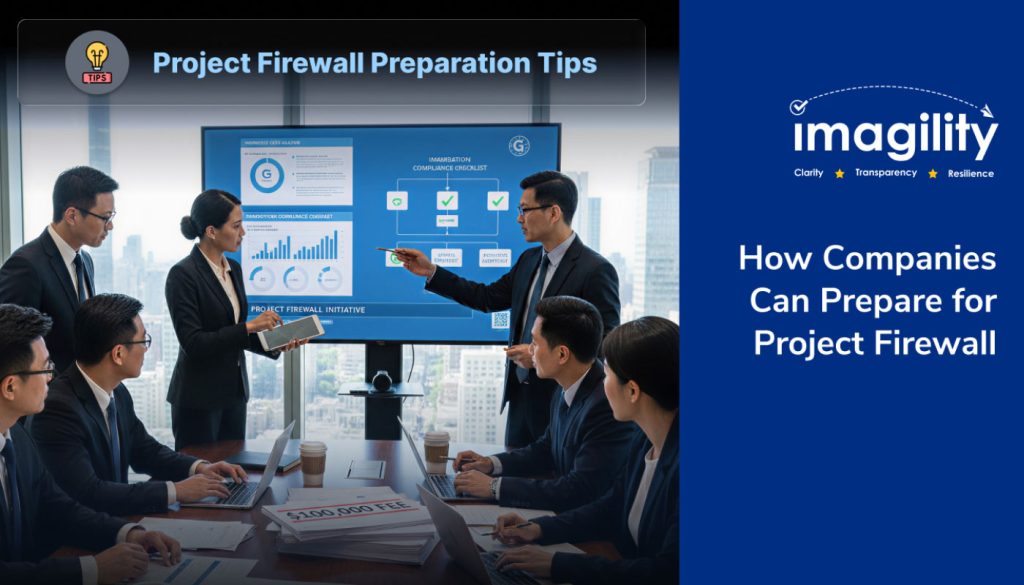On September 19, 2025, the U.S. Department of Labor (DOL) launched Project Firewall, a strict new enforcement program for H-1B employers. Unlike before, when investigations often started after an employee complaint, the DOL can now begin audits on its own if it suspects noncompliance.
For U.S. employers, especially IT staffing firms, large corporations, and universities with many H-1B workers, this means more scrutiny and higher stakes. Fines can reach $25,000 per violation, along with back wages, visa program bans, and reputational harm. Below are seven practical steps to prepare for Project Firewall.
Step 1: Know What Project Firewall Covers
Project Firewall looks closely at how companies manage their H-1B workforce. Areas under the microscope include:
- Paying workers fairly (no underpayment or unpaid “benching”).
- Keeping accurate LCAs and Public Access Files (PAFs).
- Posting worksite notices and updating LCAs when employees move.
- Treating H-1B workers fairly and without discrimination.
- Making sure records are consistent across agencies like DOL, USCIS, IRS, and SSA.
Step 2: Run Your Own Self-Audit
Before the DOL visits, employers should check themselves. That means:
- Reviewing PAFs for accuracy.
- Comparing payroll records to LCA wage requirements.
- Confirming no benching without pay.
- Making sure worksite locations in LCAs match where employees actually work.
- Organizing immigration filings in one secure place.
Step 3: Improve Documentation Habits
Good records are your best defense in an audit. Employers should:
- Keep all certified LCAs, wage memos, and posting notices handy.
- Maintain payroll files, W-2s, and timesheets for each worker.
- Update employee rosters with job titles, visa status, and worksites.
- Store I-9s, E-Verify results, and USCIS petitions securely.
Step 4: Assign Responsibility
Compliance works best when someone owns it. Companies should:
- Appoint a compliance officer or team.
- Train HR, recruiters, and managers regularly.
- Hold quarterly reviews to catch mistakes early.
Use checklists and risk assessments to stay organized.
Step 5: Use Technology to Stay Ahead
Manual tracking is risky. Employers can reduce mistakes with compliance technology. Platforms like Imagility help by:
- Automating PAF creation and storage.
- Tracking visa expirations and posting deadlines.
- Matching payroll data with LCAs.
- Producing audit-ready reports on demand.
Step 6: Be Ready for an Audit
Every company should know what to do if the DOL comes knocking:
- Have an audit response team (HR, compliance, legal, outside counsel).
- Practice producing documents within 72 hours — the DOL’s standard.
- Keep a “Firewall Binder” ready with PAFs, payroll data, employee rosters, and immigration filings.
- Have a plan for communicating with employees, clients, and partners if an audit occurs.
Step 7: Keep Up with Policy Changes
Project Firewall is just the start. Employers should:
- Follow announcements from DOL, USCIS, and DHS.
- Join industry groups to stay informed.
- Partner with legal or compliance experts for advice.
- Update company policies as new rules roll out.
Project Firewall Employer Risk Self-Assessment Checklist
To put these steps into action, use this quick self-assessment tool. Answer Yes / No / Unsure to each. Any “No” or “Unsure” signals a compliance gap that needs fixing.
- Wage Compliance
☐ Do all H-1B workers receive at least their certified LCA wage?
☐ Are they paid during nonproductive periods (no unpaid benching)?
☐ Do you have a written system explaining how wages are set? - LCA & Public Access File (PAF)
☐ Is there a complete PAF for every LCA?
☐ Does each file include the certified LCA, wage data, and benefits summary?
☐ Do you have proof of posting notices at worksites? - Worksite Verification
☐ Are H-1B employees only working at locations listed in the LCA?
☐ Are postings documented for remote or client sites?
☐ Are LCAs updated when employees change jobs or locations? - Payroll & Benefits
☐ Do payroll records match certified wages?
☐ Do H-1B workers get the same benefits as U.S. workers?
☐ Can wage and payroll records be produced within 72 hours? - Immigration Records
☐ Do you keep copies of all petitions, LCAs, and approvals?
☐ Is there an updated roster of H-1B employees with job details?
☐ Do you check filings for errors before submission? - Training & Oversight
☐ Has HR and recruiting staff been trained in the last year?
☐ Do you run quarterly internal audits?
☐ Is there a compliance officer or partner responsible for oversight?
How to Score
- 18–20 Yes → Low Risk (audit-ready).
- 12–17 Yes → Moderate Risk (fix gaps soon).
- Below 12 Yes → High Risk (vulnerable to penalties).
Conclusion
Project Firewall has raised the bar for H-1B compliance. Companies that stay proactive through audits, better documentation, clear ownership, and the use of technology will not only avoid penalties but also protect their ability to hire international talent.
If you are unsure about your company’s readiness, now is the time to act. Imagility can help you run self-audits, monitor compliance, and leverage AI-powered tools to stay fully prepared for Project Firewall.
Contact us today to schedule a compliance review and see how Imagility can simplify your compliance journey.
Book a free demo now and protect your business from costly risks.










